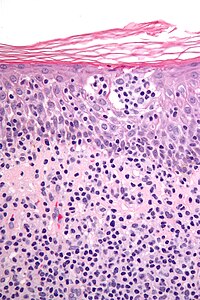Cutaneous T cell lymphoma
| Cutaneous T cell lymphoma | |
|---|---|
 |
|
| Micrograph showing cutaneous T-cell lymphoma. H&E stain. | |
| Classification and external resources | |
| Specialty | Hematology and oncology |
| ICD-10 | C84.0, C84.1 |
| ICD-9-CM | 202.1, 202.2 |
| ICD-O | M9700/3, M9701/3 |
| DiseasesDB | 8595 |
| eMedicine | med/3486 |
| MeSH | D016410 |
Cutaneous T cell lymphoma (CTCL) is a class of non-Hodgkin lymphoma, which is a type of cancer of the immune system. Unlike most non-Hodgkin lymphomas (which are generally B cell related), CTCL is caused by a mutation of T cells. The malignant T cells in the body initially migrate to the skin, causing various lesions to appear. These lesions change shape as the disease progresses, typically beginning as what appears to be a rash which can be very itchy and eventually forming plaques and tumors before metastasizing to other parts of the body.
Cutaneous T-cell lymphomas may be divided into the following types:
A WHO-EORTC classification has been developed.
There is no cure for CTCL, but there are a variety of treatment options available and some CTCL patients are able to live normal lives with this cancer, although symptoms can be debilitating and painful, even in earlier stages.
FDA approved treatments are:
Other (off label) treatments include:
Other drugs are under investigation (for example: panobinostat, Resimmune, resiquimod and synthetic hypericin).
In 2010, the U.S. Food and Drug Administration granted orphan drug designation for a topical treatment for pruritus in cutaneous T-cell lymphoma to a pharmaceutical company called Elorac.
Of all cancers involving the same class of blood cell, 2% of cases are cutaneous T cell lymphomas.
There is some evidence of a relationship with human T-lymphotropic virus.
...
Wikipedia
